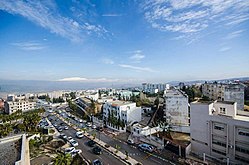Type a search term to find related articles by LIMS subject matter experts gathered from the most trusted and dynamic collaboration tools in the laboratory informatics industry.
Mila
ميلة ⵎⵉⵍⴰ | |
|---|---|
city | |
 Mila city | |
 city Mila in Mila Province | |
| Coordinates: 36°27′00″N 6°16′00″E / 36.45°N 6.266667°E | |
| Country | |
| Province | Mila Province |
| District | Mila District |
| Area | |
• Total | 129.89 km2 (50.15 sq mi) |
| Population (2008) | |
• Total | 69,052 |
| Time zone | UTC+1 (CET) |
Mila (Arabic: ميلة, mīla, [miːla]) is a city in the northeast of Algeria and the capital of Mila Province. In antiquity, it was known as Milevum (in Latin; as such still a Latin Catholic titular see) or Miraeon, Μιραίον (in Ancient Greek) and was situated in the Roman province of Numidia.
In Ptolemy's Geography, IV, iii, 7, the city is mentioned under the name of Mileum or Mireon. During the Roman era it was called Colonia Sarnensis Milevitana, after the River Sarnus in Campania, whence the colonists had emigrated. This name is often found in the inscriptions of the city. Together with Cirta, Collo and Rusicade, Milevum formed the confederation known as the Four Colonies, the territory of which was very extensive. In the 6th century the Byzantine Emperor Justinian had Milevum enclosed by a fortified wall, which still stands and forms a rampart for the Muslim city of Mila.[1] It has yielded quite a number of Latin inscriptions from this city and a colossal statue of Saturn.
Between 665 and 682 the city was conquered by the Umayyad Arabs commanded by Abu al-Muhajir Dinar.
In multiple book mentioned precisely City Mila conquered by Abu Muhajer General Umayyad Dinar in 675 AD in it, says in "The Berbers: study on the conquest of Africa by the Arabs, according to the printed Arabic texts. "Volume 1 by Henri Fournel on page [2] The Mosque Sidi Ghanem of Mila was built around 675 by Abu Muhajer Dnar Dinar [3] In the tenth century AD, historian and geographer Abu Ubayd-Allah Abd Al-Bakri quoted the mosque of Sidi Ghanem as "the first Mila mosque adjoining Dar El Imara" (House of Command)
As multiple significant evidence was found of Mila in the Arab period, as standard weight of 745 Umayyad registered with: "'Translation: "In the name of Allah. Among the steps ordered / Emir Abd al-Rahman ibn Habib / Masal ibn Hammad, Wali Mila / twenty ûkîya (once) in the year 127-745)/" The name of the governor mentioned on the standard is well known: ‘Abd al-Rahmān ibn Habīb, the grandson of ‘Uqba ibn al-Nāfī’, who governed the Maghreb between 744 and 754 after returning from Spain, where he had taken refuge following the disastrous battle of Tangiers.[4]
In the 11th-century al-Bakri describes the Mila population as consisting of Arabs, people from the militia, and people of mixed race (Arabic, Roman and Berber).[5]
But according to al-Idrissi it remained in the 11th century that there were 4000 Kutama Berbers throughout Ifriqiya[6]
Finally in the 19th century it was the largest colony Koulouglis of the East-Algeria (Constatinnois) (mix of Turk with Arab or Berber)[7]
According to the scientist and military E.Carette (1808–1890), author of the tribal map of Algeria, and studies "inquiry into the origin and migration of the main tribes of North Africa, particularly of Algeria '"on page 453 there was a Mila 19th century about 800 ethnic Arabs and 800 ethnic Berbers in the city[8] Milevum, modern Arabic name Mila, was under French colonial rule a city in the department of Constantine in Algeria, with in the early 20th century 8000 inhabitants, 400 of whom are Europeans.
Constantine department later became Constantine Province after the independence of Algeria, of which Mila was dependent till the creation of Mila Province in 1984. At the 1998 census the city had a population of 59,959.
Milevum was among the many towns of sufficient importance in the Roman province of Numidia, in the papal sway, to become a suffragan diocese.
The historically recorded bishops of this episcopal see were
Two church councils were held at Milevum, one in 402 and the other in 416. The second appealed to Pope Innocent I for repression of the Pelagian heresy.
The bishopric is last mentioned, as one of the thirteen subsisting suffragan sees in Numidia, in the Notitiae Episcopatuum in the reign of Byzantine emperor Leo VI (886-912).
The diocese was nominally restored, no later than the 17th century, as Latin titular bishopric of Milevum (Latin) / Milevi (Curiate Italian) / Milevitan(us) (Latin adjective).
It has had the following incumbents, mostly of the fitting Episcopal (lowest) rank, with two archiepiscopal exceptions:
{{cite book}}: CS1 maint: numeric names: authors list (link)
![]() This article incorporates text from a publication now in the public domain: Herbermann, Charles, ed. (1913). "Milevum". Catholic Encyclopedia. New York: Robert Appleton Company.
36°27′01″N 6°15′52″E / 36.45028°N 6.26444°E
This article incorporates text from a publication now in the public domain: Herbermann, Charles, ed. (1913). "Milevum". Catholic Encyclopedia. New York: Robert Appleton Company.
36°27′01″N 6°15′52″E / 36.45028°N 6.26444°E